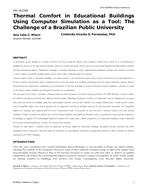Description
A prerequisite of any building is to provide security to the users, taking the climate and its physical variables into account. It is also important to highlight the relevance of the right material elements, which arise between the person and the agent, and must provide improved thermal comfort conditions and low environmental impact. Furthermore, technology is constantly advancing, as well as computational simulations, therefore, they should be considered as tools to improve sustainable building projects and to achieve higher satisfaction from the occupants.
Thermal comfort studies in educational buildings is of relative relevance, since the thermal characteristics in these environments are of vital importance to all users. Students and professors spend a significant part of their time inside these buildings, performing tasks that require intellectual capacity, which is increased when the occupant feels comfortable in the environment. In this line of thought, to evaluate university classroom conditions, a detailed case study on the thermal comfort conditions of a Brazilian University was accomplished.
The main goal of this study is to perform a thermal analysis in three classrooms at Federal University of Paraná (UFPR) (Brazil), in order to address the subjective and physical variables that influence thermal comfort. Regarding the physical variables, air temperature and air humidity were measured, both inside and outside the building, along with meteorological variables, such as solar radiation and rainfall, collected from a nearby weather station. Then, EnergyPlus software was used to reproduce the air temperature and the air humidity values of the three classrooms monitored. The EnergyPlus outputs were analyzed and compared with the on-site measurement results to be possible to come out with a conclusion related to the local thermal conditions. Finally, to evaluate the reference for the local thermal conditions and confirm the obtained results, a questionnaire survey with the occupants of the building was applied. The methodological approach included in the study allow a distinct perspective in an educational building to better understand the classroom thermal performance, as well as the reason of such behavior.
Finally, the study induces a reflection about the importance of thermal comfort for educational buildings and propose thermal alternatives for future retrofitting projects, along with a discussion about the significance of using computer simulations on engineering solutions, in order to improve the thermal performance of UFPR’s buildings.
Citation: 2018 Annual Conference, Houston, TX, Conference Papers
Product Details
- Published:
- 2018
- Number of Pages:
- 8
- Units of Measure:
- Dual
- File Size:
- 1 file , 2.2 MB
- Product Code(s):
- D-HO-18-C028




